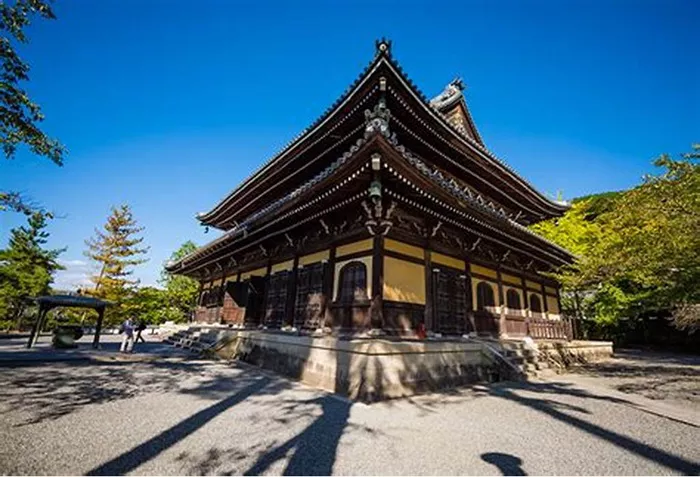Nanzen-ji is one of the most famous and important Buddhist temples in Japan. Located in Kyoto, it belongs to the Rinzai school of Zen Buddhism. This temple has a long history and plays a special role in Japanese Zen practice and culture. Many visitors come to Nanzen-ji not only for spiritual reasons but also to admire its beautiful surroundings and buddhist temple architecture.
The History of Nanzen-ji
Founding and Early Years
Nanzen-ji was first established in 1291 during the Kamakura period by Emperor Kameyama. Originally, it was built as an imperial villa before being converted into a Zen temple. The emperor wanted a place where Zen meditation and practice could flourish. Over the centuries, Nanzen-ji became one of the head temples of the Rinzai sect, which emphasizes direct experience through meditation.
Development Through Time
Over 700 years, Nanzen-ji has been rebuilt and expanded many times due to fires and wars. Each reconstruction preserved the original spirit of Zen while adding unique features that reflect the changes in Japanese culture and Buddhist practice. The temple complex includes several sub-temples, gardens, gates, and meditation halls.
The Significance of Nanzen-ji in Zen Buddhism
Center of Zen Practice
Nanzen-ji is not just a tourist site; it is a living center of Zen Buddhism. The temple is a place where monks and practitioners engage deeply in zazen — seated meditation. Zen Buddhism teaches that enlightenment comes from direct experience, not just study, and Nanzen-ji supports this practice with its tranquil environment and strict monastic training.
Teaching and Influence
The temple has produced many famous Zen masters who have influenced Buddhism both in Japan and internationally. Nanzen-ji’s teachings emphasize mindfulness, simplicity, and living fully in the present moment. These lessons are reflected in the way the temple is designed and maintained, encouraging visitors to slow down and appreciate the present.
Key Features of Nanzen-ji
Temple Architecture
Nanzen-ji’s temple architecture is a perfect example of traditional Japanese Buddhist design mixed with Zen aesthetics. The buildings are simple yet elegant, made mostly of wood with curved roofs and painted details. The main gate, called the Sanmon Gate, is one of the largest wooden gates in Japan and symbolizes the entrance to enlightenment.
Gardens and Nature
The temple gardens at Nanzen-ji are famous for their beauty and peacefulness. They are designed in the Zen style, using rocks, water, moss, and carefully pruned trees to create a natural, meditative atmosphere. Walking through these gardens allows visitors to connect with nature, which is an important part of Buddhist practice.
Sub-Temples and Meditation Halls
Nanzen-ji contains several smaller temples within its grounds. Each sub-temple has its own unique style and focus, often offering special meditation sessions or ceremonies. The meditation halls provide space for monks and visitors to practice Zen meditation quietly and without distractions.
The Role of Nanzen-ji in Modern Times
Tourism and Cultural Importance
Today, Nanzen-ji attracts thousands of visitors from around the world. Many come to learn about Zen Buddhism and to experience Japanese culture firsthand. The temple also hosts seasonal festivals, tea ceremonies, and art exhibitions that celebrate Zen philosophy and Japanese traditions.
Preserving Buddhist Architecture and Heritage
As an important cultural heritage site, Nanzen-ji helps preserve traditional buddhist architecture. Careful restoration projects maintain the temple’s buildings and gardens, ensuring they continue to inspire future generations. Nanzen-ji’s architecture teaches us about harmony between human-made structures and the natural world, a key principle in Buddhism.
Visiting Nanzen-ji: What to Expect
Spiritual Experience
Visitors to Nanzen-ji can participate in meditation sessions, attend Dharma talks, or simply walk through the temple grounds to find a moment of peace. The quiet and serene environment supports reflection and mindfulness, even for those new to Buddhism.
Architectural Appreciation
For lovers of architecture and history, Nanzen-ji offers a rich visual experience. The layout of the temple, the design of the Sanmon Gate, and the beauty of the gardens all demonstrate principles of Zen that focus on simplicity and balance.
Practical Information
Nanzen-ji is open year-round, with an entrance fee that helps support the temple’s upkeep. It is best visited in spring for cherry blossoms or autumn for colorful leaves. Nearby Kyoto provides many other temples and cultural sites, making it a perfect destination for those interested in Buddhist culture and Japanese tradition.
Conclusion
Nanzen-ji is more than just a historic temple. It is a living symbol of Zen Buddhism’s teachings and values. Its long history, beautiful temple architecture, and role as a center of meditation make it a place of great spiritual and cultural significance. Whether you come to study Buddhism, appreciate Japanese culture, or seek peace, Nanzen-ji offers a profound experience that touches the heart and mind.

